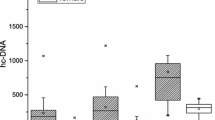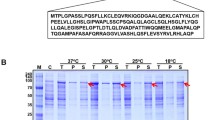Abstract
Background
Granulocyte-macrophage colony-stimulating factor (GM-CSF), one of the haemopoietic growth factors, has rarely been detected in human serum. It has, therefore, been suggested that a paracrine model can explain its behaviour where the substance is produced and acts locally. An alternative explanation might be due to blood sampling time with GM-CSF concentrations undetectable at the nadir of secretion.
Hypothesis
We hypothesised that endogenous production of GM-CSF in humans is subject to diurnal rhythm.
Methods
Blood samples were obtained from 17 healthy individuals and 17 neutropenic hospitalised patients with haematological malignancies on myelosuppressive therapy at 6, 12, 18 and 24 hours. In the neutropenic patients, samples were collected at the nadir of the neutrophil count (ANC <0.2 × 109/L). Serum was assayed for GM-CSF levels using an enzyme-linked immunosorbent assay method.
Results
There were significant differences in the mean levels of GM-CSF within the two groups (P<0.001). In normal subjects, peak GM-CSF levels were reached at six hours (mean = 10.1 pg/ml). Peak levels were reached in hospitalised neutropenic patients at 18 hours (mean = 13.7 pg/ml). The difference between the peak GM-CSF levels in the two groups was not significant (P=0.11). On factorial design analysis, there was a significant interaction between the time of blood collection and the subject groups (P<0.001).
Conclusions
Our data are consistent with a diurnal secretion pattern for GM-CSF in both normal and neutropenic patients. As this finding might have practical implications, including timing of administration of GM-CSF in neutropenic patients, further studies are suggested.
Similar content being viewed by others
References
Burgess AW, Camakaris J, Metcalf D: Purification and properties of colony-stimulating factor from mouse lung conditioned medium.J Biol Chem 1977; 252: 1998–2003.
Gough NM, Gough J, Mctcalf D, Kelso A, Grail D, Nicola NA, Burgess AW, Dunn AR: Molecular cloning of CDNA encoding a murinc haematopoietic growth regulator, granulocyte-macrophage colony stimulating factor.Nature 1984; 309: 763–7.
Gasson JC: Molecular physiology of granulocyte macrophage colony-stimulating factor.Blood 1991; 77(6): 1131–45.
Whetton AD, Dexter TM: Myeloid haemopoietic growth factors.Biochemien et Biophysica Acta 1989; 989(2): 111–132.
Fibbe WE, Van Damme J, Billiau A, Goselink HM, Voogt PJ, Van Eeden G, Ralph P, Altrock BVV, Falkenburg JH: Interleukin-l induces human stromal cells in long-term culture to produce granulocyte colony -stimulating factor and macrophage colony-stimulating factor.Blood 1988; 71(2): 430–5.
Huebner K, Isobe M, Croce CM, Golde DW, Kauffman SE, Gasson JC: The human gene encoding GM-CSF is at 5q21–q32, the chromosome region detected in the 5q — anomaly.Science 1985; 230: 1282–5.
Le Beau MM, Westbrook CA, Diaz MO, Larson RA, Rowley JD, Gasson JC, Golde DW, Sherr CJ: Evidence for the involvement of GM-CSF and FMS in the deletion (5q) in myeloid disorders.Science 1986; 231: 984–7.
Stanley E, Lieschke GJ, Grail D, Metcalf D, Hudgson G, Gall JAM, Maher DW, Cebon J, Sinickas V, Dunn AR: Granulocyte-macrophage colony-stimulating factor deficient mice show no major perturbation of hematopoiesis but develop a characteristic pulmonary pathology.Proc Nat Acad Sci USA 1994; 91 (12): 5592–6.
Layton JE, Cebon JS, Morstyn G: Cytokine responses to febrile neutropenia.Exp Hematol. 1991; 19: 506 (abstr).
Lieschke GJ, Burgess AW: Granulocyte colony stimulating factor and granulocyte-macrophage colony-stimulating factor.N Engl J Med 1992; 327(1): 28–35.
Wide L, Bengtsson C, Birgegard G: Orcadian rhythm of erythropoietin in human serum.Br J Haematol 1989; 72 (1): 85–90.
Jelinkova-Vondrasova D, Hajek I, Illnerova H. Adjustment of the human circadian system to changes of the sleep schedule under dim light at home.Neurosci Lett 1999; 265 (2): 111–14.
Chapolot F, Gronfier C, Jouny C, Muzet A, Brandenberger G. Cortisol secretion is related to electroencephalic alertness in human subjects during daytime wakerulness.J Clin Endocrinol Metnb 1998; 83 (12): 4263–8.
Kraft M, Martin RJ. Chronobiology and chronotherapy in medicine.Dis Mon 1995; 41(8): 501–75.
Kennon BR: A study of the white blood cells picture in six young men.Am J Physiol 1937; 118: 690–9.
Crispino S, Lissoni P, Ardizzoia A, Barni S, Rovelli F, Tancini G. Effects of granulocyte-macrophage colony stimulating factor on cortisol, growth hormone, prolactin and melatonin in cancer patients.J Biol Regul Homeost Agents 1992; 6(4): 142–4.
Ruef C, Coleman DL: Granulocyte-macrophage colony-stimulating factor: pleotropic cytokine with potential clinical usefulness.Rev of Inf Dis 1990; 12(1): 41–62.
Buemi M, Allegra A, Lagana A, Aloisi C, Privitera M, Morabito N, Frisina N. Effects of evening i.v. administration of erythropoietin in haemodialized patients.Riv Eur Sci Med Farmacol. 1993; 15(5–6): 195–7.
Klausen T, Poulsen TD, Fogh-Anderson N, Richalet JP, Nielsen OJ, Olsen NV. Diurnal variation of serum erythropoietin at sea level and altitude.Eur J App Physiol. 1996; 72(4): 297–302.
Perpoint B, Le-Bousse-Kerdiles C, Clay D, Smadja JF, Depres-Brummer P, Laporte-simitsidis S, Jasmin C, Levi F. In vitro chronopharmocology of recombinant mouse IL-3, mouse GM-CSF and human G-CSF on murine myleoid progenitor cells.Exp Hematol. 1995; 23(4): 362–8.
Author information
Authors and Affiliations
Rights and permissions
About this article
Cite this article
Abdelaal, M.A., Hashim, I.A., Zawawi, T.H. et al. Circadian rhythm of granulocyte-macrophage colony-stimulating factor in normal subjects and neutropenic hospitalised patients. Ir J Med Sci 169, 55–57 (2000). https://doi.org/10.1007/BF03170487
Issue Date:
DOI: https://doi.org/10.1007/BF03170487




